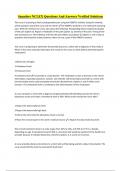Exam (elaborations)
Saunders NCLEX Questions And Answers Verified Solutions
- Course
- Institution
Saunders NCLEX Questions And Answers Verified Solutions The nurse is assessing a client's postoperative pain using the PQRSTU method. Using this method, which questions would the nurse ask the client? The PQRSTU method is one method of assessing pain. With this method, the nurse asks about ...
[Show more]



